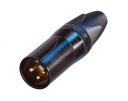 We used to do lots of church and auditorium sound system installations and many times, some sort of a patch bay was called for. While including a patch bay in an installation can be both expensive and time consuming, it is always worth the trouble, even in a simple installation.
We used to do lots of church and auditorium sound system installations and many times, some sort of a patch bay was called for. While including a patch bay in an installation can be both expensive and time consuming, it is always worth the trouble, even in a simple installation.
The industry standard for audio patch bays uses quarter inch connectors or something similar called “TT” ![]() (“TT” stands for “tiny telephone”) a standard left over from when telephone systems used physical switchboards. Early sound system patch bays actually used hardware intended for the phone company.
(“TT” stands for “tiny telephone”) a standard left over from when telephone systems used physical switchboards. Early sound system patch bays actually used hardware intended for the phone company.
We quickly realized that using the “TT” standard, even though it was embraced by console manufacturers and recording hardware makers, was not the best solution for the job.
While not universally accepted for patch bays, using the XLR standard for these patch bays was a much better solution. It’s hard to come up with a connector design better than the XLR3 connector. It is durable. It can be used balanced (3 wire) or unbalanced (2 wire), it is readily available in places like Radio Shack, and it is inexpensive.
Best of all, it doesn’t require a different kind of cable from the other wires used in most sound system installations. If you have almost any kind of sound system, you are already using XLR3 cables, as these are what is used on almost all microphones.
We tried to include patch bays in several locations along an audio signals path (both inputs and outputs) so that rerouting, patching in temporary sound sources, routing signal to temporary output sources, etc. could be done without unpatching the primary console inputs and outputs.
Using XLR connectors allows you to pass both balanced and unbalanced signals, including phantom power when necessary and use standard XLR “barrel” type adapters like ground lifts and isolation transformers. The “TT” standard does not allow for any of these adaptations.
XLR cables can be patched together “head to tail” to make as long a cable as you need. XLR cables are available in short lengths for standard patch bay use, but any size XLR microphone cable can be used.
Unlike a two pole or three pole “TT” connector, the XLR3 connector can be patched without having to pass the tip of the connector through the ring(s) of the mating female connector. The likelihood of annoying and possibly damaging “pops” and “cracks” is greatly reduced.
Need to trace a signal? Standard tone generators and cable testers can be used with the XLR patch panel without any adapters. None of this can be done with a “TT” patch panel.
If you really want flexibility in your sound system installation XLR is the way to go.
GoodBuyGuys.com is your online source for Shurtape gaffers tape, Duracell Procell batteries, MagLite flashlights, Nashua duct tape, Bay State wire ties, Electratrac and Coast Wire extension cords , OnStage Stand mic stands . View our full selection of XLR cables at BuyMicCable.com




Leave a Reply
You must be logged in to post a comment.